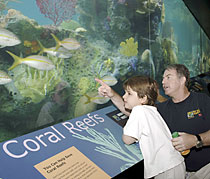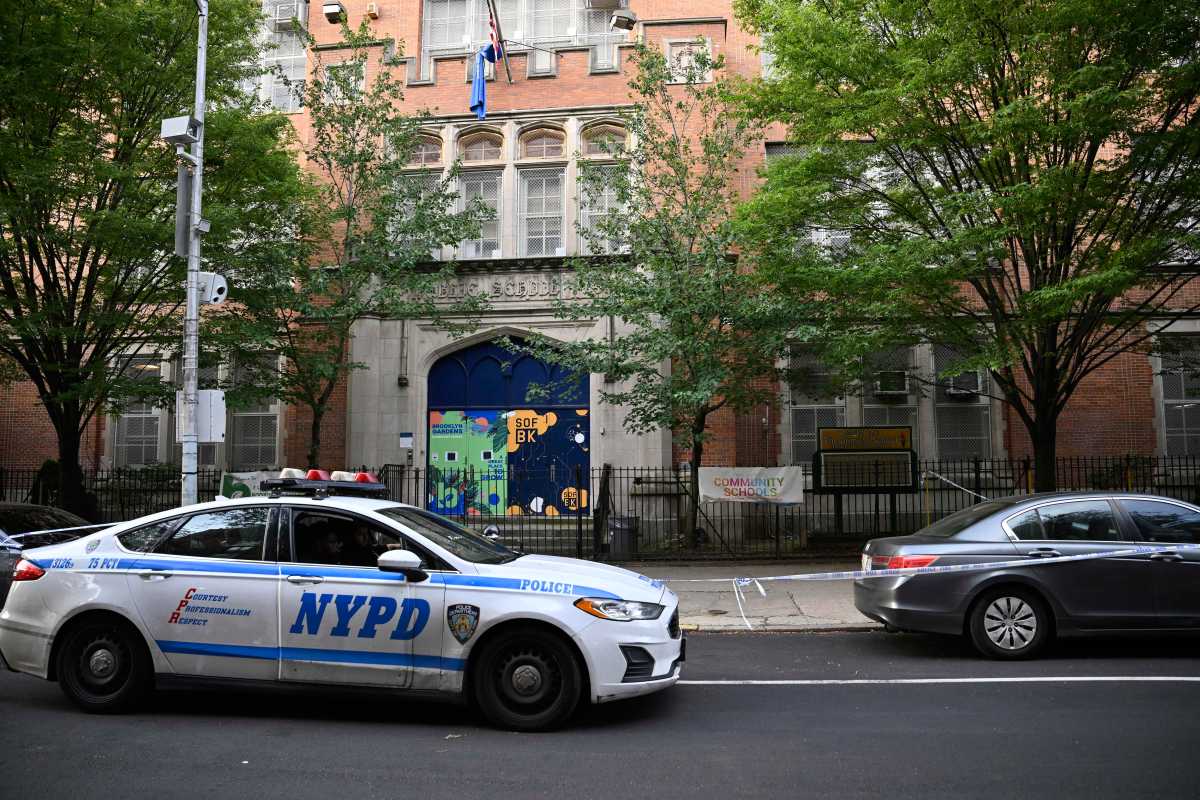From the cafe to its entrance, the New
York Aquarium in Coney Island is awash with new things to see
– and eat. Two new exhibits opened on June 7, and when visitors
need to take a break from their sightseeing, they can nosh in
the Aquarium’s new Seaside Cafe.
The first thing one sees when walking into the New York Aquarium
is the newly installed "Glover’s Reef" exhibit. This
huge tank, which holds 150,000 gallons of natural seawater, is
named for the seamount atoll in the western Caribbean off the
coast of Belize, after which it was modeled. It joins the "Bathysphere"
as one of the two newest additions to the Aquarium.
John Dohlin and his colleagues from the exhibits and graphics
department of the Bronx Zoo – both the zoo and the Aquarium are
operated by the Wildlife Conservation Society – designed the
two new exhibits. "Glover’s Reef" includes more than
35 fascinating species, including moray eels, yellowhead jawfish,
yellow goatfish, southern stingray, doctorfish and queen angelfish.
The moray eels are particularly fascinating as they spend most
of their time in the crevices, hiding from predators, and looking
for their own prey. Visitors can view the slithering attraction
at the "wall of moray eels," where three different
species of eels glide ominously while looking back at the humans
gawking mere inches away.
The exhibit offers the viewer many interesting facts about coral
reefs. They date back to about 200 million years ago and today’s
coral reefs, like the one "Glover’s Reef" was patterned
after, have been around for roughly 10,000 years. Coral is actually
a living organism and a "piece" of coral is many interconnected,
individual small coral living collectively as a colony.
"Coral reefs are important to humans because they are breeding
grounds for certain species of fish which are important for human
consumption and provide protection to tropical coastal regions
against waves that may erode the shoreline," said Dave DeNardo,
general curator for the New York Aquarium. "A great amount
of research is being done today with corals to determine if they
can provide medicinal compounds [too]."
One learns through displays at the exhibit that a coral reef
consists of skeletons from coral and other animals, minerals
and organic matter. A coral colony grows on the reef surface,
which itself provides food and shelter for many species of animals
and plants.
"The exhibit also focuses attention on ways in which coral
reefs are of direct value to people, including our visitors,
and aims to motivate people to care about the fate of coral reefs
everywhere," said Aquarium spokeswoman Fran Hackett.
"The Wildlife Conservation Society owns one of the five
tiny islands on [Glover’s Reef] and has scientists working there
to learn about coral ecology and biology and ways to diminish
human threats to these fragile habitats," she noted.
Take a ’Bath’
The 5,400-pound "Bathysphere" is the vessel that Otis
Barton and Brooklyn native William Beebe used to descend to 3,028
feet in the Atlantic Ocean on Aug. 15, 1934. At the time, they
shattered the record of 525 feet.
Amazingly, two full-grown men fit in the tiny vehicle along with
the necessary equipment, which included oxygen tanks, a barometer
and a searchlight. (At the Aquarium, visitors can peer – not
step – into the sphere.) The "Bathysphere" is 4 feet,
9 inches in diameter; the walls are an inch and a quarter thick;
the three windows are 8 inches in diameter and 3 inches thick;
and the door is only 14 inches in diameter.
It must have been quite a tight fit.
The reason for the dive was to disprove the theory that life
could not exist below 500 feet of water.
This exhibit shows artist renderings as described by Beebe and
Barton of the odd-looking species they found, including deep-sea
anglerfish, giant siphonophores, copecod, black swallower and
lanternfish.
The giant siphonophores are particularly intriguing in that they
look like a single creature, but are actually a colony of animals,
according to the exhibit. The different animals have separate
jobs; some catch prey, others digest and some move the colony
along.
In addition to Beebe and Barton’s dangerous voyage proving that
there was life below 500 feet of ocean, they proved it was a
population of fascinating creatures.
In addition to these two new exhibits, the Aquarium’s permanent
"Alien Stingers" installation shows many different
types of jellyfish, corals and anemones. Interactive computers
give visitors information about the different types of fish.
We find out, among other things, exactly what stingers are and
how they eat.
Another must-see exhibit is the "Jamaica Bay Touch Pool,"
where children can touch channeled whelk and Atlantic horseshoe
crab.
If seeing all of this seafood gives you a hunger pang, stop in
the new Seaside Cafe, which opened in March and offers a menu
of "sustainable seafood" choices.
"Glover’s Reef" and "The
Bathysphere" are on display now at the New York Aquarium
(Surf Avenue at West Eighth Street in Coney Island). Admission
is $11 for adults and $7 for children ages 2 through 12 and senior
citizens. Children under the age of 2 are admitted free.
On Father’s Day – this Sunday, June 19 – from 11 am to noon,
the Aquarium hosts a "That’s My Dad!" event featuring
a penguin role-play game and exploration of parenting efforts
of aquatic dads. The fee for this program – $23, $18 members
(parent/child pair) – includes admission to the Aquarium. Appropriate
for ages 3 to 4.
Also on Father’s Day, from noon to 4 pm, the Aquarium will offer
other activities (such as making seahorse-themed crafts for dad
and sea lion demonstrations in the Aquatheater) that are free
with admission.
For more information, call (718) 265-FISH or visit the Web site
at www.nyaquarium.com.

























